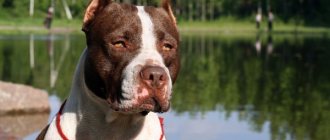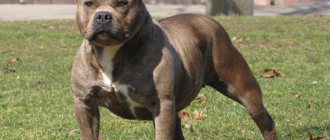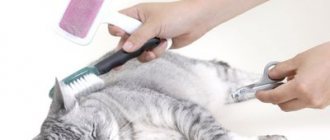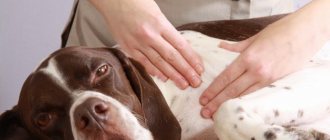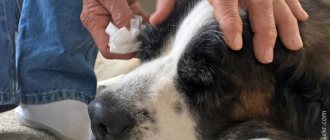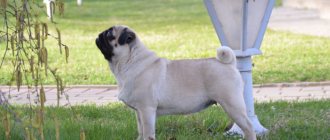Different breeds of dogs, especially decorative ones, which were bred through complex selection, are prone to various diseases. Therefore, when choosing small pets, you need to know which dogs have eye loss so that you can recognize the disease in time and provide first aid to the animal with further treatment.
Many owners have seen how dogs' eyes fall out, but not everyone knows the etiology of this phenomenon.
General information about the disease
When hearing the phrase “the dog’s eye fell out,” many imagine the following picture: the organ of vision literally fell out onto the floor. But this is not true at all. A disease characterized by eye loss is called proptosis. This is a strong forward displacement of the apple, which leads to the fact that it begins to roll out of its orbit. The eye cannot return to its anatomical position on its own due to spasms of the muscles of the eyelid.
The cornea dries out, is constantly damaged, and the blood circulation process in it is disrupted.
Attention! The disease not only leads to aesthetic problems. A dog whose eyes are bulging out may soon lose his sight.
How much does a Chihuahua cost?
Their miniature size and cheerful disposition have made the Chihuahua a popular urban breed. That’s why the cost of these babies can be steep. The average price of a dog is 40-50 thousand rubles. It is better to buy a puppy from a nursery that specializes in this breed. It is always risky to take one by hand, since there is no guarantee that the dog will have all the characteristics of the breed, pedigree and documents.
Of course, the lack of documents does not make the pet less loved. But the presence of a pedigree and origin from a kennel guarantees that the dog meets the requirements of the breed. This means that you can initially be confident in her character and state of health. A puppy of unknown origin may turn out to be overly aggressive or, conversely, passive and painful. And the road to dog shows, of course, will be closed to you.
pixabay.com/
Causes of eyeball loss in dogs, symptoms
Dogs whose eyes fall out have a special skull structure - a small skull, with a flat shape on top, a shortened muzzle. Because of this structure, the eyeballs are not set deep enough, and under the influence of provoking factors the dog can stare them out.
Causes and provoking factors for the development of proptosis:
- frequent carrying of the pet by the withers;
- the dog making a sharp jump from a great height;
- insect bites to the skull area;
- wearing a tightly tightened collar, which puts pressure on the neck, increasing intracranial pressure;
- frequent stress;
- the owner’s habit of sharply or strongly pulling the animal’s leash;
- injuries to the head, face or neck;
- frequent and prolonged stay outside in very hot weather;
- severe fear of the animal.
Pathology can occur suddenly, for example, during an active walk, when playing with other animals or household members. The disease can also be provoked by the fact that the decorative dog climbed the high stairs too quickly, making jerky jumps.
Additional Information! The eye may pop out partially or completely out of the orbit.
Any, even minor loads can lead to vision pathologies.
Symptomatic picture
Immediately at the very moment of injury, when the eye flies out of the orbit, the rectus muscles are torn. The animal feels pain, fear and severe discomfort.
Proptosis is accompanied by the formation of a hematoma. You can understand that a pet has developed a pathology by its changed behavior and a number of visible signs:
- blinking too often;
- bloody discharge from the eyeball;
- proptosis is visible and so - the dog will bulge its eye to a considerable distance;
- swelling of the conjunctiva;
- drying and discoloration of the cornea, it becomes dull and faded;
- the dog becomes passive and depressed.
The animal cannot be exposed to bright light, which causes pain.
Proptosis is impossible to miss
Retinal detachment and atrophy
A hereditary disease caused by eye abnormalities, injuries, high blood pressure - detachment. The disease is characterized by a rapid course. Sudden hemorrhage, severe blindness, and impaired pupil reflex occur. Retinal detachment is practically incurable. Requires surgery and antibacterial drugs.
Atrophy is a hereditary genetic problem. It manifests itself as a slow decrease in the quality of vision: first in the dark, then in daylight, complete blindness and clouding of the pupil. The disease is incurable.
Breeds Prone to Eye Loss
When purchasing small decorative pets, you need to know which dogs have protruding eyes in order to prevent the development of pathology and preserve vision.
Pugs
The sad look of the pug is known to everyone; this is its highlight, which is also its Achilles heel. Pugs are the most famous dogs with protruding eyes.
The predisposition to proptosis is genetic, and all due to the fact that there is no protrusion on the muzzle near the nose, the function of which is to protect the organs of vision from mechanical damage.
Attention! During walks, pugs' eyes are often damaged by grains of dirt, sand, or grass. Due to such damage, eye inflammation and other ophthalmological diseases develop, and proptosis is their consequence.
Pekingese
The deformed structure of the skull and muzzle, coupled with wide eye sockets, are factors that greatly increase the risk of proptosis. The peculiarity of Pekingese is that they are more susceptible to eye pathology, because their eye muscles are weak and do not provide reliable attachment. Provoking factors:
- difficult bowel movements, in which internal pressure rises;
- jumping;
- climbing stairs, especially several floors;
- squeezing the neck with a collar.
It is difficult to prevent proptosis in Pekingese dogs; even careful adherence to preventive measures does not greatly reduce the risk of pathology in old age.
Shar Pei
In Shar Peis, the risk of proptosis is associated with two factors - the characteristics of the skin and improper care of the animal. The presence of numerous folds of different sizes is caused by low skin tone. Because of this, strabismus often occurs; the eyelids may roll up, which provokes disturbances in the location of the eyes in the apple.
Attention! Proptosis can be caused by actions of the owner such as frequently carrying the Shar Pei by the withers, spanking the neck or face.
Although the Shar Pei is a fairly large animal, it must be handled very carefully.
Shih Tzu
Congenital pathology of the organs of vision, which is manifested by incomplete closure of the bony orbit due to the special structure of the skull, leads to systematic stretching of the muscle fibers of the eye.
As a consequence, there is a predisposition to ophthalmological diseases, in particular to proptosis. Since the Shitzu often gets sick in the eyes, it is necessary to carefully carry out preventive measures.
Additional Information! Two other species that are susceptible to proptosis are Spitz dogs and Chihuahuas. The fact that the Chihuahua's eye has fallen out is due to frequent injuries to the organs of vision due to the shortened muzzle. A strong blow or jump are provoking factors.
History of the Japanese Chin
Japanese Chin
It is indisputable that the Japanese Chin is one of the oldest dog breeds, but versions of its origin are still being discussed. According to one of them, the breed is truly Japanese, another claims that chins were brought to the Land of the Rising Sun from neighboring countries of South Asia, but the routes along which they got there are not exactly known. There is a legend that a pair of dogs similar to the Japanese chin were presented as a gift to the Japanese Emperor Semu by the ruler of one of the Korean states of Silla in 732. It is also possible that these dogs settled in the Japanese imperial court back in the 6th-7th centuries. The earliest estimated date for the appearance of chins in Japan is the 3rd century, and India and China are considered the exporting countries in this case.
Recently, historians in the field of cynology are inclined to believe that the Japanese Chin is one of the many breeds that belong to the so-called “toy” dogs of China, which trace their ancestry to Tibetan dogs. Among them, in addition to the Chin, they also include the Shih Tzu, Lhasa Apso, Pekingese, Pug, and Tibetan Spaniel, which, by the way, has nothing in common with the hunting spaniel. All these animals are distinguished by a large head, large eyes, a short neck, a wide chest, and thick hair - features that indicate their adaptability to the highland climate. The version of the family ties connecting these dogs is confirmed by recent genetic studies. Graceful miniature dogs have been bred for centuries, living in Buddhist monasteries and imperial courts. It is known that the religious and secular elites of Tibet, China, Korea, and Japan exchanged their pets and presented them to each other as gifts.
The first written sources describing the Japanese chin date back to the 12th century. Like their relatives, they were considered sacred and were adored by their owners - crowned persons and representatives of the aristocracy. Legends were written about chins, their images decorated temples and luxurious porcelain vases, and craftsmen working with wood, ivory, and bronze embodied the image of these miniature animals when creating elegant figurines. Purposeful work on breeding this breed began in Japan in the 14th century; information was entered into stud books and kept in the strictest confidence. It is known that the most valued were very miniature pets, which easily fit on small sofa cushions, in the sleeves of the kimonos of noble ladies, they were even placed in hanging cages, like birds. In the 17th century, the families of the daimyo, the samurai elite, chose the hin as their mascot. Commoners were prohibited from keeping Japanese chins, and their theft was considered a crime against the state and was punishable by death.
Japanese Chin puppy
The origin of the breed's name is also controversial. It is believed that the word “hin” comes from the Chinese almost consonant word meaning “dog”. According to another version, it comes from the Japanese “hii”, meaning “treasure”, “jewel”, which, by the way, was quite consistent with its status in monetary terms.
According to some data, although not fully clarified, the first Japanese chins were brought to Europe in 1613 by Portuguese sailors. One of the dogs, or a couple, ended up at the court of the English King Charles II, where they became the favorites of his wife Catherine of Braganza. Perhaps at the same time representatives of this breed appeared in Spain. More reliable information indicates that Japanese chins appeared in Europe and the New World thanks to US Navy Commodore Matthew Calbraith Perry, who led an expedition to Japan in 1853 to establish trade relations. He delivered five of the chins presented to him as a gift by the Japanese Emperor to his homeland, and one pair was presented to Queen Victoria of England.
The development of trade between Japan and European countries, which began in the middle of the last century, opened up the possibility of exporting chins to the continent, and systematic breeding of the breed began in many countries. In Europe, Japanese Chins quickly gained popularity as companion dogs and became favorites of queens, empresses and ladies of high society. They inherited the tradition of the Japanese elite and presented their pets to each other as gifts. The Chins prospered at the courts of all the royal families of Europe. The most famous lover of these dogs was the wife of the English monarch Edward VII, Queen Alexandra, who never parted with her many favorites. Members of the family of Emperor Nicholas II also adored their little pets. By the way, the Soviet elite also favored this breed. One of the most famous owners of the pampered Japanese Chin was the stern Marshal Georgy Zhukov.
The breed was first shown at an exhibition in Birmingham in 1873. Here the chin appeared under the name “Japanese spaniel”. In the USA, this name was retained for dogs until 1977. The American Kennel Club recognized this breed under this name back in 1888, and it is one of the earliest registered by this organization.
In the 20s of the last century, systematic work was carried out to improve the Japanese Chin breed. Before World War II, selection was carried out in several directions. The largest representatives of the breed were called Kobe, the medium-sized ones were called Yamato, and the almost dwarf ones were called Edo. The appearance of modern Chins contains features of all three types of dogs.
The FCI recognized the Japanese Chin as a distinct breed in 1957, classifying it as a toy and companion dog.
In the Soviet Union, few people knew about the breed until the 80s of the last century, when six chins arrived in Moscow, presented as a gift to Russian diplomats upon completion of their service in Japan. With the help of these dogs, Russian chin enthusiasts set to work to improve the health and improvement of the breed. Today, in many nurseries in Moscow and St. Petersburg, Japanese chins are bred, whose ancestors were these six souvenir animals.
Black and white and red and white Japanese chins
Rules and recommendations for eye care in dogs
Animals with a predisposition to proptosis require regular and careful care for their visual organs. Recommendations for hygiene procedures:
- At least once a week, the corners of the eyes are wiped to remove accumulated secretions. The procedure is carried out using a piece of gauze or a sterile napkin soaked in boiled, clean water or a special eye care product. A separate napkin is used to treat each eye.
- Carrying out a thorough eye examination for possible damage after a walk.
- If dust or other particles are found in the eyes, they must be removed immediately using special drops that increase lacrimation and wash the eyeball.
- If the animal has folds on its face, they need to be wiped off after a walk and every meal so that dust does not accumulate there and inflammatory processes do not occur.
If any abnormal discharge or injury to the apple is detected, you should immediately contact a veterinarian.
Eye care is the most important preventive measure
Glaucoma
Glaucoma or “green star” is a group of diseases associated with increased pressure inside the visual apparatus. They are characterized by redness of the eye, significant enlargement of the pupil, and a greenish cataract. During the course of the disease, photophobia, apathy, enlargement of the eyeball, and slower pupil reaction are observed. The problem is hereditary, and certain breeds are genetically predisposed to it.
Treatment does not give a 100% result, but it can slow down development. First of all, they reduce the pressure inside the eye. Then they use the cyclocryotherapy method: cold to the ciliary body. Medicines prescribed for pets are aimed at improving the outflow of intraocular fluid.
| List of drugs for treatment | ||
| Name of medicine | Price | Release form and application |
| Azopt | 947 rubles per bottle (5 ml) | Eye drops that suppress fluid production by almost half |
| Alphagan | 718 rubles per bottle (5 ml) | Drops that reduce pressure inside the eye and increase the outflow of fluid; apply 2-3 times a day, 1-2 drops |
Any disease can lead to injury or atrophy of the eye, but individual diseases of the mucous membranes also occur. It is important for the owner not to get confused and start treatment on time: contact a veterinarian, start using medications.
4.7 / 5 ( 3 voices)
First aid
The further course of the disease and the prognosis for the future depend on how correctly and quickly the owner reacts to proptosis in the pet. First aid measures:
- Protect the eye from further damage, from touching and possible contact with various objects. To do this, a special collar is put on the animal’s neck, or you will have to hold its paws for a while so that the pet does not harm itself while trying to relieve the pain.
- Using a clean piece of cloth or sterile gauze soaked in saline solution or clean cool water, gently wipe the skin around the eyes, removing blood particles and other contaminants.
- Lubricate the cornea with ophthalmic ointment.
- To reduce pain and prevent severe swelling, you can apply an ice cube wrapped in a cloth to the skin under the eye. Keep cold for no more than 15 minutes.
After providing first aid, the animal must be taken to the veterinarian as quickly as possible so that the eye can be put back in place.
The operation requires anesthesia, so you cannot feed the pet before visiting the veterinary clinic.
After the operation, the animal will recover in 2 weeks - 1 month. During the rehabilitation period, it is necessary to provide the pet with complete rest and proper, careful care. Antibiotics are given to prevent infections.
Attention! The recurrence of proptosis in most cases leads to the need to remove the damaged organ.
Ulcerative keratitis
Severe inflammation of the cornea of the eye. Causes: mechanical damage and trauma (burns, foreign bodies, bruises), infections, reactions to drugs, allergies, vitamin deficiency. It may occur due to diseases of the immune system, in particular diabetes.
Vivid symptoms: suppuration and tearing, fear of light, a cloudy area in the affected area, the presence of ulcers on the cornea, frequent blinking, redness of the white. The consequence of improper treatment is glaucoma, cataracts, blindness.
| List of drugs for treatment | ||
| Name of medicine | Price | Release form and application |
| Levomycytin | 50-60 rubles per bottle | Eye drops are used 4 times a day, 2-3 drops into the conjunctiva; |
| Erythromycin ointment | 90 rubles per tube | Antibiotic ointment is applied around the eyes and on the eyelid of the dog 2-3 times a day, the timing of use depends on the severity of the disease |
What to do is strictly prohibited
It is prohibited to use products containing alcohol, hydrogen peroxide, or other antiseptics with aggressive compounds to process apples. There are no attempts to insert the eye into place on your own or touch it with your hands.
It is strictly forbidden to use cotton pads or pieces of cotton wool to wipe the eyes, as their particles can stick to the cornea, only aggravating the condition of the organ of vision.
Do not wipe with cotton wool or alcohol
Treatment
Pekingese - description of the breed and character
If you are planning to get a Pekingese, then first read the description of the Pekingese breed; in addition to its advantages, there are also disadvantages.
Most often, after realignment of the eye, temporary sutures are placed on the eyelids. This operation is called “blepharorrhaphy”.
Even after the eye has been set in place, there is a possibility that some kind of infection has entered the body, so the doctor must definitely prescribe you treatment.
It is imperative to wash your eyes and drop drops. The doctor may prescribe you chloramphenicol, tsipromed, tobrex, normax, leopard, gentamicin eye drops.
Preventive actions
If a dog has been adopted with drooping eyelids and a genetic predisposition to proptosis, the owner of such a pet should regularly take preventive measures to prevent the disease. These are simple measures that will help significantly reduce the likelihood of pathology:
- Neither puppies, nor adults, nor even small pets should be picked up by the scruff of the neck, much less carried in this state.
- Animals with a distinctive structure of the skull and muzzle, when the eyes are too close or there is weakness in the muscle fibers, are not recommended to be allowed to play with other animals or small children.
- Regular eye hygiene procedures.
- It is necessary to remove household items or toys with sharp edges from the room in which the pet is located. These can cause damage to the animal's eyes.
- Pekingese, which have a very high predisposition to proptosis, are best carried from high floors by hand. Frequently climbing stairs increases the risk of developing ophthalmological diseases.
Walking on the street is carried out on a leash so that it is possible to control the pet’s behavior.
One of the radical methods of prevention is canthoplasty. This is a surgical intervention, the essence of which is to reduce the ocular incision, due to which the organ of vision is better protected from the occurrence of proptosis.
Proptosis is a common disease; many animals have a genetic predisposition. Due to the commonality of provoking factors for the appearance of pathology, it is necessary to carry out preventive work to prevent the disease, often resorting to a drastic measure - surgery. Otherwise, there is a risk that the pet will lose an eye.
How to choose a puppy
Whatever kind of Japanese Chin puppy you decide to buy - a show-class dog or just a pet, it is important, first of all, to choose a seller. This can be a reliable, responsible breeder, and ideally, the owner of a breeding nursery that has a good reputation and a documented history of breeding the breed in this particular nursery. Professionals in their field will always select exactly the puppy you dream of, issue documents confirming that he is healthy, a certificate of pedigree, and characteristics of his potential breeding qualities.
First, make sure that the puppies are kept in a clean room and observe them. Check to see if all puppies from the same litter look healthy, are active, and are well fed. Examine the baby that you like the most from head to tail. Make sure that his ears are clean, without redness, his eyes are clear and playful, his gums are pink, his teeth are white, his fur is silky and shiny. Suspicion should be raised by any sign of underbite or overbite.
Take a closer look at the Chin you like at the moment when he plays. Such an observation will help to notice whether he has noticeable defects: a “cow-like” stance of the hind legs, their instability, an excessively lowered sternum. These shortcomings are rarely leveled out with age.
It is very important to make sure that the parents of your potential pet do not have diseases, and also to clarify whether the bitch was ill during pregnancy, since in this case the puppies may develop pathologies, including such a dangerous disease as hydrocephalus. You also need to take a closer look at the puppy’s mother, and if you choose a Japanese Chin with show prospects, it is advisable to see both parents.
Nicknames for Chihuahuas
It is believed that the name reflects the character of the pet, so name the baby what you want to see him in the future.
Boys' names can be fighting names, such as Rimbaud, Tyson or Hunter. In comparison with a miniature dog, such nicknames will sound funny, but not unreasonable. Chihuahua boys have more than enough fighting qualities. Archie, Prince, Oscar, Dani, Richie will sound more aristocratic. You can remember the Mexican origin of the baby and name him Amigo. The cheerful nicknames Shustrik, Funtik, Kipish, Bublik, Peach and others go well with their mischievous appearance.
Girls' names, as a rule, are elegant and cute, like the dogs themselves: Adele, Emmy, Felicia, Maurice, Bella, Grace, Lady, Nicole - there are a lot of options. You can give the baby a cool name; Button, Knopka, Mushka, Fifa, Lala will suit her. Or in the American style: Happy, Bebby, Julie, Blackie, Goldie - these names can reflect both the baby’s character and her color.

